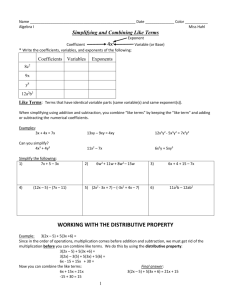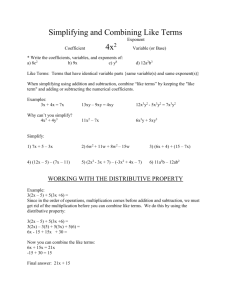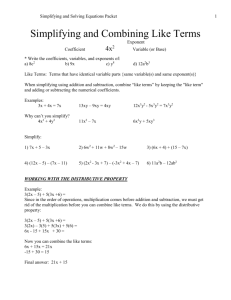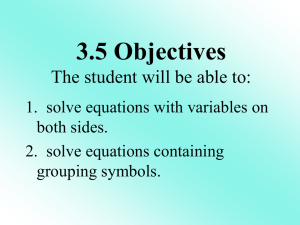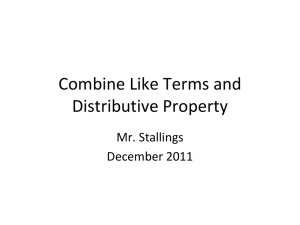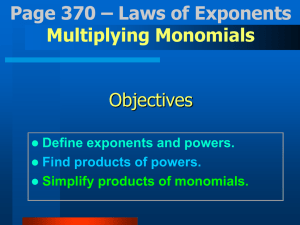Alg1 NOTES simplifying monomials FOIL equations
advertisement
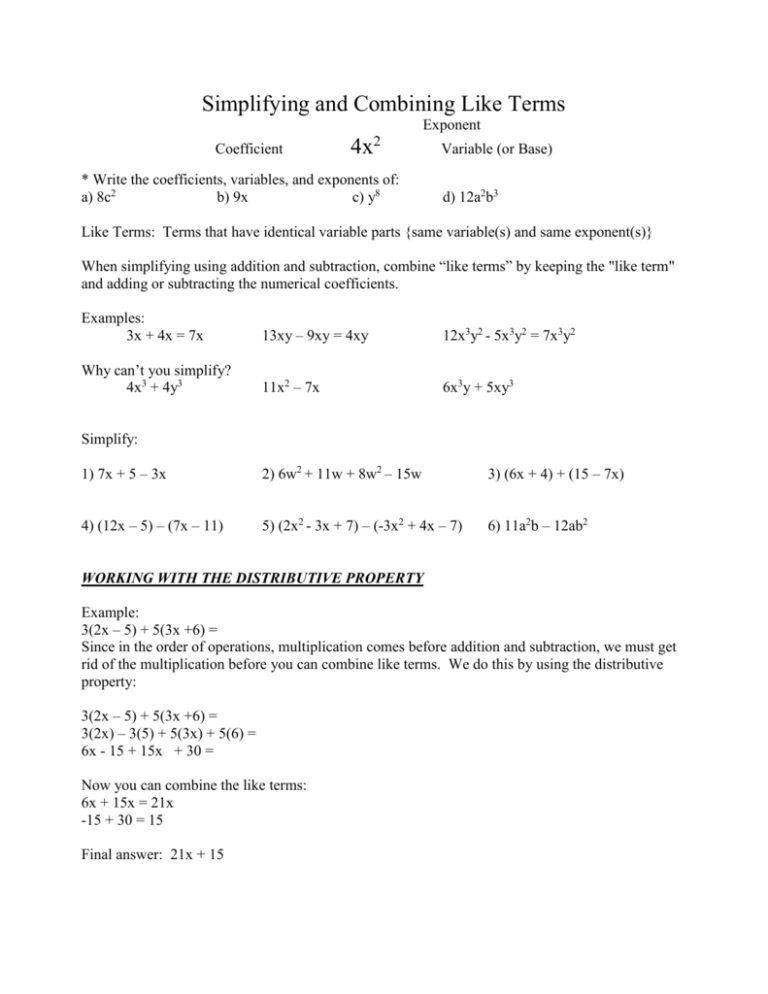
Simplifying and Combining Like Terms
Exponent
Coefficient
4x2
* Write the coefficients, variables, and exponents of:
a) 8c2
b) 9x
c) y8
Variable (or Base)
d) 12a2b3
Like Terms: Terms that have identical variable parts {same variable(s) and same exponent(s)}
When simplifying using addition and subtraction, combine “like terms” by keeping the "like term"
and adding or subtracting the numerical coefficients.
Examples:
3x + 4x = 7x
13xy – 9xy = 4xy
12x3y2 - 5x3y2 = 7x3y2
Why can’t you simplify?
4x3 + 4y3
11x2 – 7x
6x3y + 5xy3
Simplify:
1) 7x + 5 – 3x
2) 6w2 + 11w + 8w2 – 15w
3) (6x + 4) + (15 – 7x)
4) (12x – 5) – (7x – 11)
5) (2x2 - 3x + 7) – (-3x2 + 4x – 7)
6) 11a2b – 12ab2
WORKING WITH THE DISTRIBUTIVE PROPERTY
Example:
3(2x – 5) + 5(3x +6) =
Since in the order of operations, multiplication comes before addition and subtraction, we must get
rid of the multiplication before you can combine like terms. We do this by using the distributive
property:
3(2x – 5) + 5(3x +6) =
3(2x) – 3(5) + 5(3x) + 5(6) =
6x - 15 + 15x + 30 =
Now you can combine the like terms:
6x + 15x = 21x
-15 + 30 = 15
Final answer: 21x + 15
Simplify:
1) (5x – 4) + (3 – 4x)
2) (7x4 – 6x3 + 4x2 –11x + 5) – (9x4 + x3 + 8x2 –13x - 4)
3) 3(5x-3) + 6(2x+4)
4) 7(2x2 – 6x + 2) + 3(-5x2 + 14x – 4)
5) 9(7x2 – 5x + 9) – 7(8x2 – 3x +12)
6) 6(3x3 – 4x2 +11x –5) – 10(-2x3 – 6x2 + 6x + 7)
7) 4(2x2 + 6x + 5) – 8(x2 + 3x –5)
8) 7(4x2 – 3x +2) + 9(3x – 6)
9) 12(3x2 – 6x +9) – 9(4x2 – 8x –12)
10) 5(6x3 – 4x2 + 11) – 6(5x2 + 9)
11) 10(3x4 – 5x3 + 7x2 –10x + 6) – 5(6x4 – 10x3 –14x2 –20x + 12)
Multiplying and Dividing Monomials
Multiplying:
32 = 3 3 = 9
4 4 = 42 = 16
43 = (4) (4) (4) = 64
(5)(5)(5)(5)(5)(5) = 56=15,625
The same goes for variables:
x x = x2
x2 x3 = (x)(x) (x)(x)(x) = x5
(The only difference is you can’t simplify x2 like you did 32 = 9. You must leave it as x2.)
When multiplying monomials you must deal with the coefficients.
Coefficients: Multiply the coefficients.
Variables:
When multiplying the variables of monomials you keep the base and add the
exponents. (Remember if there is no exponent written, the exponent is 1.)
Look at the previous example:
x1 x1 = x(1+1) = x2
Simplify: (3xy5)(4x2y3)
(3xy5)(4x2y3) = (3)(4)(x)( x2)(y5)(y3) = 12 [x(1+2) ][y(5+3)] = 12x3y8
Dividing:
64/62 = (6)(6)(6)(6)
(6)(6)
3
x /x = (x)(x)(x)
(x)
cancel (6)(6) (6)(6) = (6)(6) = 62= 36
(6)(6)
cancel (x)(x) (x) = (x)(x) = x2
(x)
Just like multiplying, when dividing monomials you must deal with the coefficients.
Coefficients : Divide the coefficients.
Variables: When dividing the variables of monomials you keep the base and subtract the
exponents.
Look at the previous example: x3/x = x3-1 = x2
Simplify: (12xy5)/(4xy3) =
12/4 = 3
x1-1 = x0
What is x0 equal to? :
Final answer =
y5-3 = y2
Any number or variable with an exponent of 0 = ?
1) Multiply:
a) (5x3y2z11)(12 xy7z-4)
b) (9x5y2z4)3
c) (4x3y7z6)4(3x8y -5z -12)2
2) Multiply:
a) (6x3y2z-12)(11x5y-3 z7)
b) (8x5y-2z4)4
c) (3x6y5z8)3(5x-9y 5z -15)2
3) Divide:
a) 27x3y2z5 .
9x3y5z4
b) (4x4y5z)3
16x4y13z4
c) (2x5yz6)5
(4x11y5z14)2
4) Divide:
a) 45x3y9z5 .
18x6y5z
b) 24x8y12z9
72x10y12z8
c) 32x5y12z28
8x7y-12z14
5) (3x5y8z5)5
(9x14y20z12)2
6) (6x5y4z6)3
(12x7y8z-9)2
7) 5a(8a2 – 6a + 3) – 3a(11a2 – 10a – 5)
8) 8b(7b2 – 4b + 2) – 5(6b2 + 3b – 1)
9) 7x(4x2 - 11x + 3) - 4x(8x2 -18x + 5)
10) 5x(7x2 - 6x + 4) - 3x(10x2 -7x - 1)
11) (x + 7)(x + 5)
Multiplying binomials:
We have a special way of remembering how to multiply binomials called FOIL:
F:
first x x = x2
(x + 7)(x + 5)
O:
outer x 5 = 5x
I:
inner 7 x = 7x
x2 + 5x +7x + 35 (then simplify)
L:
last
7 5 = 35
x2 + 12x + 35
1) (x - 5)(x + 4)
2) (x - 6)(x - 3)
3) (x + 4)(x + 7)
4) (x + 3)(x - 7)
5) (3x - 5)(2x + 8)
6) (11x - 7)(5x + 3)
7) (4x - 9)(9x + 4)
8)(x - 2)(x + 2)
9) (x - 2)(x - 2)
10) (x - 2)2
11) (5x - 4) 2
12) (3x + 2)2
Solving Equations
Golden Rule of Algebra:
“Do unto one side of the equal sign as you will do to the other…”
Whatever you do on one side of the equal sign, you MUST do the same exact thing on
the other side. If you multiply by -2 on the left side, you have to multiply by -2 on the other. If
you subtract 15 from one side, you must subtract 15 from the other. You can do whatever you want
(to get the x by itself) as long as you do it on both sides of the equal sign.
Solving Single Step Equations:
To solve single step equations, you do the opposite of whatever the operation is. The
opposite of addition is subtraction and the opposite of multiplication is division.
Solve for x:
2) x – 11 = 19
5) (x/-5) = 3
1) x + 5 = 12
4) 5x = -30
3) 22 – x = 17
6) ⅔ x = - 8
Solving Multi-Step Equations:
3x – 5 = 22
To get the x by itself, you will need to get rid of the 5 and the 3.
+5 +5
We do this by going in opposite order of PEMDAS. We get rid
of addition and subtraction first.
3x
3
= 27
3
Then, we get rid of multiplication and division.
x =9
We check the answer by putting it back in the original equation:
3x - 5 = 22, x = 9
3(9) - 5 = 22
27 - 5 = 22
22 = 22 (It checks)
Simple Equations:
1) 9x - 11 = -38
2) 160 = 7x + 6
3) 32 - 6x = 53
4) -4 = 42 - 4x
5) ¾x - 11 = 16
6) 37 = 25 - (2/3)x
7) 4x – 7 = -23
8) 12x + 9 = - 15
9) 21 – 4x = 45
10) (x/7) – 4 = 4
11) (-x/5) + 3 = 7
12) 26 = 60 – 2x
Equations with more than 1 x on the same side of the equal sign:
You need to simplify (combine like terms) and then use the same steps as a multi-step equation.
Example:
9x + 11 – 5x + 10 = -15
4x + 21 = -15
Now it looks like a multistep eq. that we did in the 1 st
-21 -21
Use subtraction to get rid of the addition.
4x
= -36
4
4
Now divide to get rid of the multiplication
9x – 5x = 4x and
11 + 10 = 21
x
13) 15x - 24 - 4x = -79
= -9
14) 102 = 69 - 7x + 3x
15) 3(2x - 5) - 4x = 33
16) 3(4x - 5) + 2(11 - 2x) = 43
17) 9(3x + 6) - 6(7x - 3) = 12
18) 7(4x - 5) - 4(6x + 5) = -91
19) 8(4x + 2) + 5(3x - 7) = 122
Equations with x's on BOTH sides of the equal sign:
You need to "Get the X's on one side and the numbers on the other." Then you can solve.
Example: 12x – 11 = 7x + 9
-7x
-7x
5x – 11 = 9
+11 +11
5x
= 20
5
5
x
Move the x’s to one side.
Now it looks like a multistep equation that we did in the 1 st section.
Add to get rid of the subtraction.
Now divide to get rid of the multiplication
=4
20) 11x - 3 = 7x + 25
21) 22 - 4x = 12x + 126
23) ¾x - 12 = ½x -6
24) 5(2x + 4) = 4(3x + 7)
25) 12(3x + 4) = 6(7x + 2) 26) 3x - 25 = 11x - 5 + 2x
